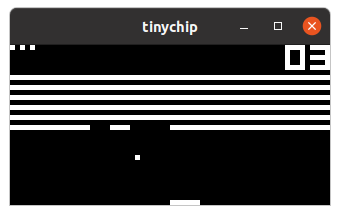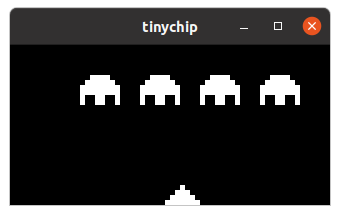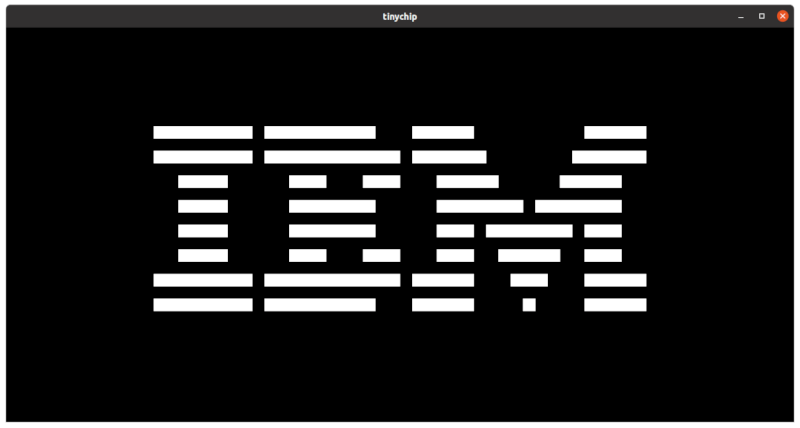2 releases
| 0.1.1 | May 5, 2023 |
|---|---|
| 0.1.0 | May 5, 2023 |
#131 in Emulators
73KB
2K
SLoC
❇️ tinychip
CHIP-8 is an interpreted programming language, developed by Joseph Weisbecker made on his 1802 Microprocessor. It was initially used on the COSMAC VIP and Telmac 1800 8-bit microcomputers in the mid-1970s. - Wikipedia
It is able to supports multiple graphical APIs and multiple interpreter implementations. We consider an instruction ~= 1 cycle, so 500hz means it executes 500 instructions per second.
📖 How to build and run ?
- Install the dependencies
cargoSDL2(as library)
- Compile and install it
cargo install --path .
- Run
tinychip --help
👍 Tested programs
| Name | Status |
|---|---|
| IBM logo | ✅ |
| Pong | ✅ |
| Space invaders | ✅ |
| Tetris | ✅ |
🖼️ Screenshots
Breakout (320x160 - 500hz)

Space Invaders (320x160 - 500hz)

IBM logo (640x320 - 500hz)

⌨️ Corresponding hotkeys
| 1 | 2 | 3 | 4 |
| A | Z | E | R |
| Q | S | D | F |
| W | X | C | V |
🔗 Compatibility
Some descriptions of the chip8 instructions differ depending on the machine. For example, the instructions 8xy6 and 8xye do not do the same thing according to the documents.
In general throughout the documents there are two kinds of semantic for the load operations (fx55, fx65) and for the shift operations (8xy6, 8xye).
Semantics
To use the original semantic, use the following flags:
- Load :
--original-load=true - Shift :
--original-shift=true
| Opcode | Default | Original |
|---|---|---|
| 8xy6 | Vx = Vx >> 1, Vf = carry | Vx = Vy >> 1, Vf = carry |
| 8xye | Vx = Vx << 1, Vf = carry | Vx = Vy << 1, Vf = carry |
| fx55 | I = I + x + 1 | ❌ |
| fx65 | I = I + x + 1 | ❌ |
Games
Some games where we know the best compatibility settings, Github issue.
ℹ️ CLI help
USAGE:
tinychip [OPTIONS] <rom>
FLAGS:
--help Prints help information
-V, --version Prints version information
OPTIONS:
--api <api> Graphical API, value(s): sfml, sdl
--cycles <cycles> Cycle(s) per second (Hz)
-h, --height <height> Window height
--interpreter <interpreter> Interpreter, value(s): original
--original-load <original-load> use the original semantic for fx55, fx65
--original-shift <original-shift> use the original semantic for 8xy6, 8xye
-w, --width <width> Window width
ARGS:
<rom> Input file
🐋 Docker playground
🔨 Build
docker build -t tinychip .
🎉 Run example
In the example below, we have:
X11as graphic serverPulseAudioas sound server
docker run -it \
-e DISPLAY=$DISPLAY \
-v /tmp/.X11-unix:/tmp/.X11-unix \
-v /dev/dri:/dev/dri \
-v /dev/snd:/dev/snd \
-v $PWD/roms:/roms \
-v /run/user/$(id -u)/pulse/native:/run/user/$(id -u)/pulse/native \
-e PULSE_SERVER=unix:/run/user/$(id -u)/pulse/native \
-u $(id -u):$(id -u) \
tinychip /roms/brick.ch8
✅ Todo
| Name | Status |
|---|---|
| 500Hz clock | ✅ |
| Basic instructions | ✅ |
| Handle every CLI args ¹ | ✅ |
| Debug features ² | ⚠️ |
| Create font | ✅ |
| Add beep sound | ✅ |
| 60Hz delay and sound timers | ✅ |
¹ CLI args:
- Clock (optional)
- Window size (optional)
- Graphical API (optional)
- Interpreter (optional)
- quirks (shift and load)
² Features:
- Pause the game
- Show interpreter values like registers, pc, keys, etc..
- Switch between a limited amount of stored emulation state
ℹ️ Documentation
Run cargo doc --open to read the documentation in the browser.
Dependencies
~20MB
~418K SLoC